Green Building Report
Raised Floors: A Green Building Advantage
Presented by the U.S. Green Building Council and Building Operating Management
In 1993, the Commonwealth of Pennsylvania’s Department of Environmental Protection occupied the newly constructed Rachel Carson State Office Building, a traditional 16-story government office structure. When it was designed in the early 1980s, green buildings were unheard of. Raised- floor systems were used extensively in computer rooms; the rationale for their use was to provide additional HVAC infrastructure and to make it easier to accommodate wiring and cabling changes. The Carson building was typical for the time: modular furniture, full-height demountable walls, a variable air volume HVAC system with ceiling air distribution — and no raised floors. The construction cost was slightly more than $40 million.
In the years since the Carson Building was completed, it has seen plenty of internal reconfiguring — an estimated 375 workstations per year. What’s more, the state has begun to focus on green design in new construction. A look at what the Carson building missed shows how raised floors can help make a design both green and cost-effective.
A raised-floor system has lots to offer green building design. The big benefit is that it creates an under-floor plenum for HVAC air distribution. Occupant-adjustable air diffusers in the floor allow individuals to adjust temperature and ventilation in work areas while the constant-volume, low-pressure distribution system provides consistent temperature, good ventilation and humidification, and good indoor air quality throughout the facility.
The raised-floor system also provides an estimated 20 to 35 percent energy savings compared to ducted ceiling systems.
In addition, recent research suggests that, in new construction, first costs of under-floor air systems are equal to or lower than ceiling HVAC systems. This is because under-floor systems usually have smaller piping, pumps and refrigeration equipment, and the majority of ductwork is eliminated. One study estimated under-floor air systems cost $2.70 per square foot less than conventional systems.
But this green option for sustainable buildings also has much to offer facilities in terms of reducing churn costs. The HVAC system, wires and cables in the under-floor plenum are accessible through individual moveable carpet and floor tiles. These capabilities, coupled with demountable wall systems and systems furniture, provide the foundation for many years of cost-efficient churn.
Churn Cost
In today’s work environment, churn is a major issue. A 1997 survey by the International Facilities Management Association (IFMA) determined that, on average, 44 percent of occupants move per year. In government buildings, this churn rate is 27 percent. The survey found that the churn rate has been increasing over time.
And all this moving is expensive. According to IFMA, the average move in the government cost $1,340. The cost of a move depends on the extent to which the facility must be modified to accommodate the changes. IFMA found that when new walls, new or additional wiring, new telecommunications systems, or other construction was needed to complete the move, the average cost in a government setting was $3,640. However, if no furniture is moved, no wiring or telecommunication system changes are required, and only files and supplies are moved, the average cost dropped to $166.
The raised-floor system significantly reduces both churn costs and renovation time. No ductwork revisions or other complex construction is needed to alter workstation or work-area configurations. The access-floor system, together with floor diffusers, allows modifications to the layout of the space to be completed with very little lost work time. The cost of a move in a building with a raised floor and movable partitions would be closer to $166 than to $3,640.
What would a high-performance green building with a raised floor have meant for the Carson Building? With an annual churn rate of 25 percent, the reconfiguration of 375 workstations annually at a cost of $2,500 per reconfiguration totaled $937,500. If a raised floor would have been used, that cost would have been $93,750 — an $800,000 savings. What’s more, there would likely have been energy costs savings and gains in IAQ and occupant satisfaction.
Churn cost savings also would have accrued at a rate of greater than 2 percent of its constructed cost per year. Presented in another way, had the Carson Building been designed and constructed as a high- performance green building with a raised floor, it would have saved about $7.6 million in churn costs since its occupancy in 1993. That’s a lot of green.
— James S. Toothaker is a green building consultant and former bureau director of the Department of Environmental Protection, Commonwealth of Pennsylvania.
Fedrizzi Tapped to Lead Council
Rick Fedrizzi, founding chairman of the U.S. Green Building Council, expects as the new president and CEO of the USGBC to handle what can only be considered a good problem: Keeping up with the demands of success.
Coping with growth for green buildings today and in the near future may be the number one challenge facing the council’s new leader. That’s especially true with the launch of it’s second green building rating system later this year — LEED for existing buildings or LEED-EB.
With the potential market for LEED-EB being 80 percent of the commercial and institutional buildings in the country, even a market penetration of 2 to 4 percent — what LEED for new construction has currently reached, according to Fedrizzi — could easily overwhelm the modest though hardworking and committed staff of this nonprofit.
“We won’t have the budget to increase staff by 80 percent, certainly, so we are looking to technology and a more sophisticated IT infrastructure to help us handle the demand for services,” he says.
The growth is driven by a marketplace that’s beginning to understand green buildings’ performance benefits, he says.
And not just any growth, but exponential growth in three to five years as the awareness of the health and productivity benefits of green buildings spreads, he says.
All this talk of managing growth seems a far cry from the council’s modest beginnings, a time Fedrizzi as a founding chairman remembers well.
“We had fantasies of what the future might hold,” he says. “We talked about numbers like a 1,000 to 2,000 members back when we had 375, but those were just numbers, not anything real. Today, with more than 4,700 members, they are real.”
Fedrizzi says he is also interested in building on the base of green buildings and hoping to reach beyond the top 25 percent of the marketplace by helping to shepherd for approval a refined but not significantly changed LEED for new construction version 3.0 in the near future.
Despite the council’s popularity, it has stuck to its roots — to help protect the environment, Fedrizzi says. That message alone probably would have never brought the level of success it has, however.
“It was then, and is, now, all about the environment, but that message wasn’t getting buildings built, ” he says. “That green buildings can affect the bottom line, and by the way are good for the environment, that’s what is driving the industry.”
Fedrizzi replaces Christine Ervin, who was the council’s first president and CEO. Her commuting from Portland, Ore., made it difficult to be a full-time leader.
The council has stuck with most of its 2003 officers for 2004. Jim Hartzfeld with Interface Americas is again chairman; Mary Tucker with the City of San Jose, Calif., is vice chairman and was also re-elected to the board of directors; Alex Wilson with Environmental Building News is secretary; and Paul von Paumgartten with Johnson Controls is treasurer. Kevin Hydes with Keen Engineering has been elected as a new co-vice chairman.
Briefings
Walls with eyes, ears... Tiny prototype computers, about the size of Lincoln’s forehead on a penny, may be the key to stemming the next blackout, improving indoor comfort or tracking the safety of a building following an earthquake.
These miniscule computers, currently being tested in buildings, are embedded in new tiny wireless sensors that, for example, can be placed in a building to control energy use. Connected to the utility, they could even help curtail loads to head off a power shortage or take advantage of real-time pricing.
Plus, the technology will help lower the cost of building sensors. Most of the cost — and potential environmental impact — of a sensor network is in the wiring.
Researchers are working to make the sensors even smaller and able to operate longer.
Promise and peril... While fuel cells hold much promise for providing clean and reliable power, they are still a developing technology with much room for improvement in both technical performance and cost, says the American Council for an Energy-Efficient Economy in a new report, “Stationary Fuel Cells: Future Promise, Current Hype.”
A critical problem is emissions that fuel cells indirectly create. Fuel cells use hydrogen to produce electricity. But fossil fuels, such as natural gas, are the source for most of the hydrogen. The process used to generate hydrogen could itself generate so much carbon dioxide that other sources of power might be more attractive if carbon dioxide limits were ever imposed.
Relocatable greenness... As portable classrooms proliferate in the United States, concerns about the energy efficiency and indoor environmental quality of these buildings have risen. As a result, Lawrence Berkeley National Laboratory, working with schools and manufacturers, has designed a cost-effective relocatable classroom.
What does it look like? To start with, it has an indirect/direct evaporative cooler and a gas heating system. The evaporative cooler system can be up to 70 percent more energy efficient than a standard SEER 10 heat pump and is quieter.
The relocatable classroom also has more insulation, a reflective roofing system, low-e windows and energy efficient lighting.
Units were tested in the Central Valley area of California, where temperatures vary considerably, and in the San Francisco area. The evaporative cooler proved to be 50 percent more efficient and provide better air quality than the traditional heat-pump system.
Best could be better... Improving indoor air quality through the purchase of low- or no-VOC recycled products may be trickier than anyone thought.
A recent study looked at standard products and green counterparts. But according to the “Building Material Emissions Study,” by the California Integrated Waste Management Board, alternative products, while better, often still exceeded the state’s limits on emissions.
Some of the results: None of the alternative ceiling tile products exceeded test limits; two of five green carpeting products tested exceeded test limits while eight of nine standard carpet products exceeded test limits; and none of the alternative paints exceeded test limits while one of four standard paints exceeded test limits.
Of the products that exceeded test limits, most did so by exceeding limits for one chemical. The chemicals that most often exceeded limits were naphthalene, formaldehyde and acetaldehyde.
Buying Green... The Center for a New American Dream invites all organizations that purchase environmentally preferable products or services to report their undertakings.
Through the Web site, organizations can tell the Center what efforts are made to make environmentally conscious purchases and share written policies to buy safer products and services.
Giving CFCs a heave ho... A new bill, H.R. 3953, would change the depreciation period for HVAC equipment from 39 years to 15 years; if it becomes law, it could expedite the change to non-CFC chillers.
A green space all their own... Hot on the heels of this year’s expected launch of the U.S. Green Building Council’s LEED-EB for existing buildings rating system is the unveiling of LEED-CI, a rating system for commercial interiors. Having nearly completed its pilot phase, LEED-CI is expected to be made official later this summer, and with it will be an opportunity for tenants to make their own green statement.
Like its predecessors, LEED-NC for new construction and LEED-EB, LEED-CI evaluates greenness using five categories: sustainable sites, water efficiency, energy and atmosphere, materials and resources, and indoor environmental quality. Certification is based on the accumulation of points towards credits, which are given for design techniques and technologies useful in creating a green interior. For instance, to receive Indoor Environmental Quality Credit 1, a tenant would have to use carbon dioxide monitors.
The pilot phase has been useful in helping to understand the system better, says Keith Winn, LEED-CI pilot project coordinator, vice chair of the LEED-CI committee and principal with Catalyst Partners.
“Finding the right buildings will go a long way in helping tenants achieve a LEED-CI rating,” Winn says. That’s because some of what LEED-CI relies on could be out of the control of tenants, such as the HVAC system or existence of a cool roof on the building.
“LEED-CI is out there to help change the marketplace of buildings not only inside but outside,” Winn says. “Tenants have the checkbook so they do have some clout in these areas.”
City’s Goal: To Meet Green and Preservation Guidelines
Cambridge, Mass. The practice of “greening” a building and the practice of historic preservation are often seen as incompatible. Not any more. The City of Cambridge, Mass., with the help of HKT, an architecture firm, registered the City Hall Annex renovation under the LEED (Leadership in Energy and Environmental Design) rating system with the goal of Gold rating.
The Annex — a 33,216-square-foot-building built in 1871 — developed a bad mold problem and was in need of a major remediation, says Rich Rossi, deputy city manager with the City of Cambridge. “We decided it presented an opportunity to demonstrate that a municipality could take a leadership position by completely redesigning the building with historic preservation, energy efficiency, renewable energy and environmental sustainability as primary goals.”
The trick was meeting both the guidelines of LEED and those of the Cambridge Historic Commission. A careful collaboration of city officials, architects and engineers and historic preservation experts came to loggerheads only twice in the process. The design called for photovoltaic panels on the roof to be set at a 45-degree angle, which would have made them visible from the street. At the sacrifice of some efficiency in their use, the panels were laid flat on the roof instead. Still, the 28-kilowatt system provides about 10 percent of the building’s electricity load. Another challenge was finding thermally glazed windows that matched the original ones and met the state energy code as well.
The 2003 building design took advantage of the large window openings and used the daylight streaming in to light 90 percent of the space. Low-e glazing and occupancy sensors help cut lighting energy use significantly. Overall energy use is projected to be 56 percent less than a conventional building.
The Annex uses a displacement ventilation system and a heat recovery system in public meeting rooms to ensure energy efficient control of the 100 percent outside air provided for these spaces. The building also uses a ground-source heat pump connected to three 1,500-foot wells, which meets all the building’s heating and cooling needs.
The $7 million renovation, finished in February 2004, was capped with a green, but historically accurate, grand entry hall.
Bill Hammer, principal of HKT, says sustainable design isn’t limited to new construction. “It is achievable in a historic preservation project and makes a lot of economic sense.”
Multi-tenant Pilot Project Targets Green Core and Shell
Seattle Located in Seattle’s South Lake Union neighborhood, a burgeoning life sciences research area, the five-story, 116,000-square-foot building located at 307 Westlake Ave. may soon be a subject for research itself. One of the first pilot projects for the Leadership in Energy and Environmental Design green building rating system for building core and shell (LEED-CS), the facility includes wet labs, clinical space and office support space to accommodate the building’s two major tenants: Seattle Biomedical Research Institute and Children’s Hospital and Regional Medical Center, which will also use the facility for medical research.
The designers of the building were challenged with defining the boundaries between tenant improvement and core and shell in several areas, including energy, daylighting, indoor air quality and carbon dioxide monitoring, says Jane Simmons of O’Brien and Company, a consulting firm that worked with the project team to determine the feasibility of pursuing LEED.
Because of the intensive energy and water requirements of lab space, the designers, based on Simmons’ recommendation, used LEED-CS instead of LEED for new construction (LEED-NC) for the building’s certification.
“One major difference between the requirements for a medical research building and any other type of building was the use of 100 percent outside air VAV systems, which were required by lab ventilation requirements,” says Beverly Tiedje of Collins Woerman, the project’s architect. The building’s HVAC system produces 10 to 12 air changes per hour, which requires an increase in energy compared with other buildings’ HVAC systems, says Simmons. Overall, though, because of an innovative heat recovery system, a carbon dioxide monitoring system and other energy efficient features, the building is expected to exceed Seattle energy code by approximately 20 percent.
Water requirements are also greater for lab space, but 307 Westlake should receive credit for reduced water through the use of waterless urinals and low-flow toilets, says Tiedje.
The designers also met core-and-shell protocol by recycling 85 percent of construction waste and using 13.5 percent by cost recycled content in core and shell materials. Underground parking, as opposed to a surface lot, and a reflective roof help reduce the urban heat island effect. The building owner’s goal is a LEED-CS silver certification.
U.S. Green Building Council
Chairman
James E. Hartzfeld
Interface Americas
Vice Chair
Kevin Hydes
Keen Engineering
Vice Chair
Mary Tucker
City of San Jose, Calif.
Secretary
Alex Wilson
Environmental Building News
Treasurer
Paul von Paumgartten
Johnson Controls, Inc.
Founder
David A. Gottfried
WorldBuild Technology Inc.
Founder
Michael L. Italiano
Sustainable Products Corp.
President, CEO and Founding Chairman
S. Richard Fedrizzi
U.S. Green Building Council
1015 18th St., NW Ste. 805
Washington, DC 20036
202/828-7422
Web site
e-mail
Related Topics:












